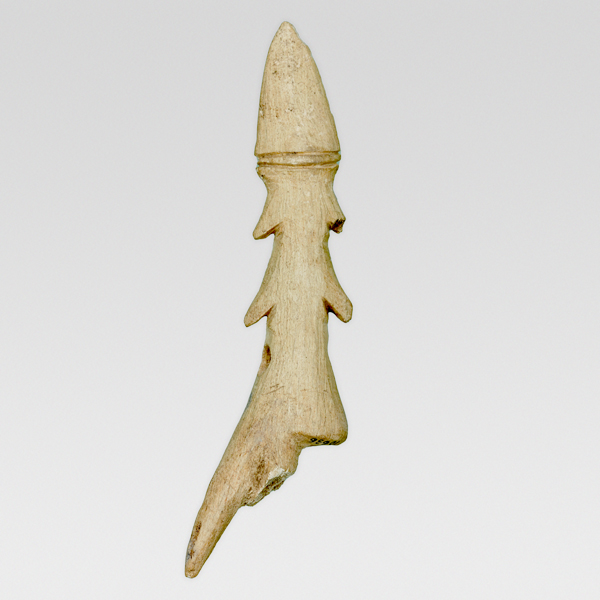縄文時代の暮らしの道具
-

燕形銛頭 岩手県陸前高田市 中沢浜貝塚出土 縄文時代(晩期)・前1000~前400年 徳川頼貞氏寄贈
平成館 考古展示室
2022年9月6日(火) ~ 2023年3月5日(日)縄文時代になると食料獲得のために採集・漁撈(ぎょろう)・狩猟が活発に行われ、そのためのさまざまな道具が用いられました。代表的な石器としては、狩猟具である石鏃(せきぞく)、木工具である磨製石斧(ませいせきふ)や土掘り具である打製石斧(だせいせきふ)に加えて、粉食具である石皿(いしざら)や磨石(すりいし)などがあります。また、骨や角で作られた鏃(やじり)・銛頭(もりがしら)・ヤス状刺突具(やすじょうしとつぐ)・釣針(つりばり)などの漁撈具の発達も見られました。
| 指定 | 名称 | 員数 | 作者・出土・伝来 | 時代・年代世紀 | 所蔵者・寄贈者・列品番号 | 備考 | |
| ヤス状刺突具 | 1個 | 茨城県つくばみらい市 神生貝塚出土 | 縄文時代(後期)・前2000~前1000年 | 徳川頼貞氏寄贈 J-10668 | |||
| ヤス状刺突具 | 1個 | 岩手県陸前高田市 獺沢貝塚出土 | 縄文時代(後~晩期)・前2000~前400年 | 徳川頼貞氏寄贈 J-16364 | |||
| 有孔ヤス状刺突具 | 1個 | 岩手県陸前高田市 中沢浜貝塚出土 | 縄文時代(後~晩期)・前2000~前400年 | 徳川頼貞氏寄贈 J-10635 | |||
| ヤス状刺突具未完成品 | 1個 | 岩手県陸前高田市 獺沢貝塚出土 | 縄文時代(後~晩期)・前2000~前400年 | 徳川頼貞氏寄贈 J-10807 | |||
| 鹿角製銛頭 | 1個 | 千葉県銚子市 余山貝塚出土 | 縄文時代(後期)・前2000~前1000年 | J-22578 | |||
| 有孔銛頭 | 1個 | 岩手県陸前高田市 獺沢貝塚出土 | 縄文時代(後~晩期)・前2000~前400年 | J-1461 | |||
| 有孔銛頭 | 1個 | 宮城県石巻市 沼津貝塚出土 | 縄文時代(後~晩期)・前2000~前400年 | 徳川頼貞氏寄贈 J-36714-C9-14 | |||
| 燕形銛頭 | 1個 | 宮城県石巻市 沼津貝塚出土 | 縄文時代(後~晩期)・前2000~前400年 | J-36714-C9-1 | |||
| おすすめ | 燕形銛頭 | 1個 | 岩手県陸前高田市 中沢浜貝塚出土 | 縄文時代(晩期)・前1000~前400年 | 徳川頼貞氏寄贈 J-10636 | ||
| 燕形銛頭 | 1個 | 岩手県陸前高田市 獺沢貝塚出土 | 縄文時代(後~晩期)・前2000~前400年 | 徳川頼貞氏寄贈 J-17334 | |||
| 燕形銛頭未完成品 | 1個 | 岩手県陸前高田市 獺沢貝塚出土 | 縄文時代(後~晩期)・前2000~前400年 | 徳川頼貞氏寄贈 J-17333 | |||
| 釣針 | 1個 | 宮城県石巻市 沼津貝塚出土 | 縄文時代(後~晩期)・前2000~前400年 | 徳川頼貞氏寄贈 J-36714-C9-34 | |||
| 釣針 | 1個 | 宮城県東松島市 響貝塚出土 | 縄文時代(後~晩期)・前2000~前400年 | J-36716-1 | |||
| おすすめ | 釣針 | 1個 | 青森県つがる市木造亀ヶ岡出土 | 縄文時代(晩期)・前1000~前400年 | 徳川頼貞氏寄贈 J-10623 | ||
| 釣針未完成品 | 1個 | 岩手県陸前高田市 獺沢貝塚出土 | 縄文時代(後~晩期)・前2000~前400年 | 徳川頼貞氏寄贈 J-10808 | |||
| 浮子 | 1個 | 千葉市若葉区 加曽利貝塚出土 | 縄文時代(中~晩期)・前3000~前400年 | 徳川頼貞氏寄贈 J-14791 | |||
| 有溝土錘 | 1個 | 千葉県市川市 曽谷貝塚出土 | 縄文時代(後期)・前2000~前1000年 | 高橋善吉氏寄贈 J-7848 | |||
| 管状土錘 | 2個 | 福島県鏡石町桜町 旧岩瀬御料地内出土 | 縄文時代(後~晩期)・前2000~前400年 | J-4752 | |||
| 有溝土錘 | 1個 | 茨城県土浦市 小松貝塚出土 | 縄文時代(晩期)・前1000~前400年 | J-2039 | |||
| 土器片錘 | 1個 | 東京都品川区大井出土 | 縄文時代(中期)・前3000~前2000年 | 徳川頼貞氏寄贈 J-19887 | |||
| 切目石錘 | 1個 | 神奈川県横浜市 三ツ沢貝塚出土 | 縄文時代(後期)・前2000~前1000年 | ニール・ゴルドン・マンロー氏寄贈 J-13836 | |||
| おすすめ | 石鏃 | 10個 | 青森県八戸市是川中居出土 | 縄文時代(後~晩期)・前2000~前400年 | 沢田熊次郎氏寄贈 J-5360 | 30個のうち10個 | |
| 鹿角製鏃 | 1個 | 岩手県陸前高田市 獺沢貝塚出土 | 縄文時代(後~晩期)・前2000~前400年 | 徳川頼貞氏寄贈 J-10655 | |||
| 鹿角製根挟み | 1個 | 出土地不詳 | 縄文時代(後~晩期)・前2000~前400年 | J-22627 | |||
| 弭形角器 | 1個 | 東京都品川区 大井権現台貝塚出土 | 縄文時代(後~晩期)・前2000~前400年 | J-22599 | |||
| 弭形角器 | 1個 | 宮城県石巻市 沼津貝塚出土 | 縄文時代(後~晩期)・前2000~前400年 | 徳川頼貞氏寄贈 J-36714-C9-31 | |||
| おすすめ | 石鋸 | 10個 | 長崎県五島市富江町出土 | 縄文時代(後期)・前2000~前1000年 | 小西元氏寄贈 J-9145 | 21個のうち10個 | |
| 石錐 | 1個 | 青森県つがる市木造亀ヶ岡出土 | 縄文時代(後~晩期)・前2000~前400年 | J-5499-1 | |||
| 石錐 | 1個 | 福島県郡山市出土 | 縄文時代(後~晩期)・前2000~前400年 | 徳川頼貞氏寄贈 J-15658 | |||
| 骨針 | 1個 | 宮城県石巻市 沼津貝塚出土 | 縄文時代(後~晩期)・前2000~前400年 | J-36714-C9-47 | |||
| 石匙 | 1個 | 北海道函館市出土 | 縄文時代(早期)・前7000~前4000年 | J-5224 | |||
| 石匙 | 1個 | 秋田県美郷町六郷石名館出土 | 縄文時代(後~晩期)・前2000~前400年 | J-36594 | 12個のうち1個 | ||
| 牙製錐 | 1個 | 千葉市若葉区 加曽利貝塚出土 | 縄文時代(後~晩期)・前2000~前400年 | J-23245 | |||
| へら状骨器 | 1個 | 岩手県陸前高田市 獺沢貝塚出土 | 縄文時代(後~晩期)・前2000~前400年 | 徳川頼貞氏寄贈 J-10825 | |||
| へら状骨器 | 1個 | 岩手県陸前高田市 獺沢貝塚出土 | 縄文時代(後~晩期)・前2000~前400年 | 徳川頼貞氏寄贈 J-19971 | |||
| 磨製石斧 | 1個 | 青森県つがる市木造亀ヶ岡出土 | 縄文時代(後~晩期)・前2000~前400年 | 徳川頼貞氏寄贈 J-15960 | |||
| おすすめ | 磨製石斧 | 1個 | 沖縄県うるま市天願出土 | 縄文時代(後期)・前2000~前1000年 | 徳川頼貞氏寄贈 J-15712 | ||
| 打製石斧 | 1個 | 神奈川県横浜市 三ツ沢貝塚出土 | 縄文時代(後期)・前2000~前1000年 | ニール・ゴルドン・マンロー氏寄贈 J-13850 | |||
| 打製石斧 | 1個 | 神奈川県横浜市 三ツ沢貝塚出土 | 縄文時代(後期)・前2000~前1000年 | ニール・ゴルドン・マンロー氏寄贈 J-13851 | |||
| 擦切磨製石斧未完成品 | 1個 | 北海道出土 | 縄文時代(早~前期)・前7000~前3000年 | J-5325 | |||
| 石皿・磨石 | 2個 | 東京都あきる野市菅生字中出土 | 縄文時代(中期)・前3000~前2000年 | 塩野半十郎氏寄贈 J-37836 |
